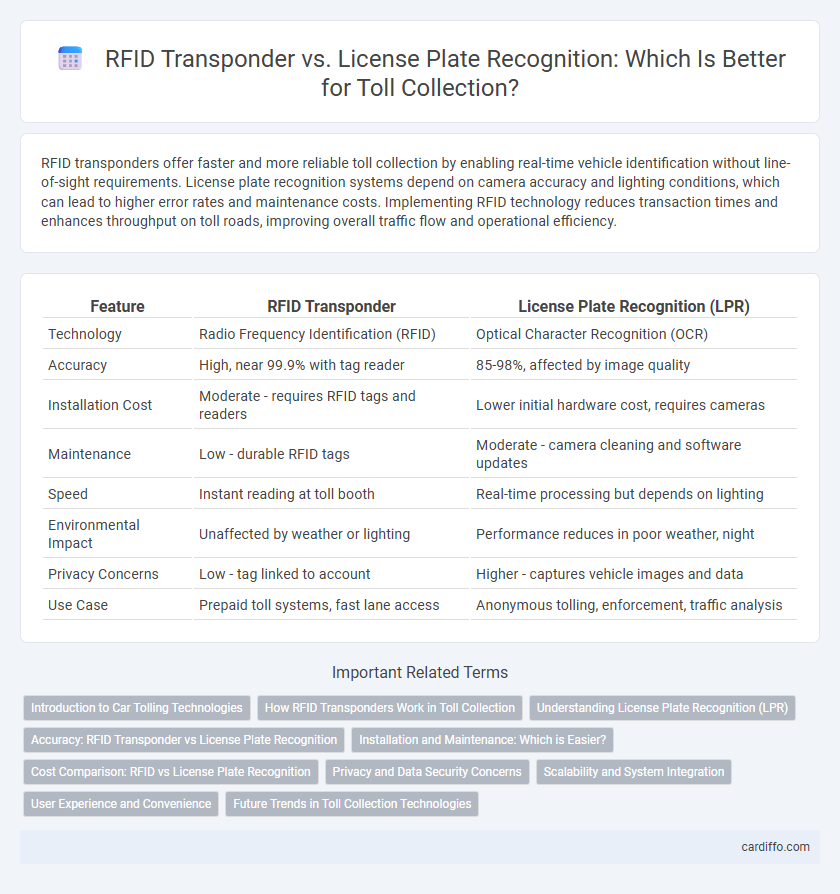RFID transponders offer faster and more reliable toll collection by enabling real-time vehicle identification without line-of-sight requirements. License plate recognition systems depend on camera accuracy and lighting conditions, which can lead to higher error rates and maintenance costs. Implementing RFID technology reduces transaction times and enhances throughput on toll roads, improving overall traffic flow and operational efficiency.
Table of Comparison
| Feature | RFID Transponder | License Plate Recognition (LPR) |
|---|---|---|
| Technology | Radio Frequency Identification (RFID) | Optical Character Recognition (OCR) |
| Accuracy | High, near 99.9% with tag reader | 85-98%, affected by image quality |
| Installation Cost | Moderate - requires RFID tags and readers | Lower initial hardware cost, requires cameras |
| Maintenance | Low - durable RFID tags | Moderate - camera cleaning and software updates |
| Speed | Instant reading at toll booth | Real-time processing but depends on lighting |
| Environmental Impact | Unaffected by weather or lighting | Performance reduces in poor weather, night |
| Privacy Concerns | Low - tag linked to account | Higher - captures vehicle images and data |
| Use Case | Prepaid toll systems, fast lane access | Anonymous tolling, enforcement, traffic analysis |
Introduction to Car Tolling Technologies
RFID transponder systems enable seamless vehicle identification through radio frequency communication, allowing for faster and more accurate toll collection compared to license plate recognition (LPR) technologies. While LPR relies on optical character recognition to capture vehicle plate information, it is more prone to errors under poor lighting or adverse weather conditions, affecting tolling efficiency. RFID's ability to uniquely identify vehicles with minimal delay enhances traffic flow and reduces congestion at toll points.
How RFID Transponders Work in Toll Collection
RFID transponders in toll collection operate by emitting radio frequency signals detected by roadside readers, enabling automatic vehicle identification without stopping. These transponders store unique vehicle data, allowing seamless communication with toll systems for efficient payment processing and faster traffic flow. Compared to license plate recognition, RFID provides higher accuracy and reliability in various weather conditions, minimizing toll evasion and reducing congestion.
Understanding License Plate Recognition (LPR)
License Plate Recognition (LPR) technology captures and processes images of vehicle license plates using optical character recognition (OCR) algorithms to identify vehicles automatically at toll points. LPR systems require extensive image processing, ambient lighting adjustments, and can be affected by factors such as dirt, plate damage, or non-standard fonts, impacting read accuracy. Compared to RFID transponders, LPR offers a contactless and infrastructure-light solution but demands robust camera networks and sophisticated software to maintain reliable toll enforcement and vehicle tracking.
Accuracy: RFID Transponder vs License Plate Recognition
RFID transponders deliver superior accuracy by consistently transmitting unique identification signals, minimizing errors caused by environmental factors. License plate recognition (LPR) systems rely heavily on image quality and lighting conditions, often resulting in reduced accuracy due to occluded or dirty plates. Studies indicate RFID systems achieve over 99% read accuracy, whereas LPR accuracy rates vary widely from 85% to 95% depending on technology and operational settings.
Installation and Maintenance: Which is Easier?
RFID transponders require installation of dedicated readers and mounting of tags on vehicles, demanding precise alignment and occasional recalibration to ensure signal accuracy. License plate recognition (LPR) systems rely on cameras with minimal physical installation, but need regular cleaning and software updates to maintain image clarity and processing accuracy. Overall, RFID transponders involve more complex hardware setup and maintenance, while LPR systems focus more on software optimization and environmental upkeep.
Cost Comparison: RFID vs License Plate Recognition
RFID transponders offer lower operational costs compared to license plate recognition systems due to minimal maintenance and high accuracy in vehicle identification. License plate recognition requires extensive infrastructure, frequent software updates, and higher error rates, which increase overall expenses. Cost analysis shows RFID systems provide better long-term savings for toll collection with reduced false readings and streamlined processing.
Privacy and Data Security Concerns
RFID transponders offer enhanced privacy by encrypting vehicle identification data, reducing the risk of unauthorized tracking compared to license plate recognition systems that publicly capture and store visual information. License plate recognition relies on cameras that can record extensive location histories, raising concerns about surveillance and data misuse. Robust encryption and secure data management in RFID systems provide stronger protections against hacking and data breaches, making them a preferred choice for privacy-conscious toll operations.
Scalability and System Integration
RFID transponders offer superior scalability compared to license plate recognition (LPR) systems by enabling high-speed processing of millions of vehicles with minimal delays and reduced infrastructure complexity. Integration of RFID technology into existing toll systems supports seamless data exchange across multiple platforms, ensuring reliable vehicle identification even under adverse weather conditions or low visibility. License plate recognition requires more computational power and frequent calibration, making system integration and expansion more challenging and less cost-effective in large-scale toll operations.
User Experience and Convenience
RFID transponders enable seamless toll payments by automatically detecting vehicles, eliminating the need for stops and reducing traffic congestion. License plate recognition relies on capturing clear image data, which can be affected by weather or plate damage, potentially causing delays or errors. Users benefit from RFID's faster processing and higher reliability, enhancing overall convenience during toll transactions.
Future Trends in Toll Collection Technologies
RFID transponder systems offer faster, more accurate vehicle identification compared to license plate recognition, reducing toll plaza congestion and improving traffic flow. Emerging trends emphasize integration of AI-enhanced LPR with RFID for multi-factor authentication, increasing system reliability and reducing fraud. Future toll collection technologies are moving towards fully automated, contactless solutions leveraging 5G connectivity and cloud-based analytics for real-time data processing and dynamic pricing.
RFID transponder vs license plate recognition Infographic

 cardiffo.com
cardiffo.com